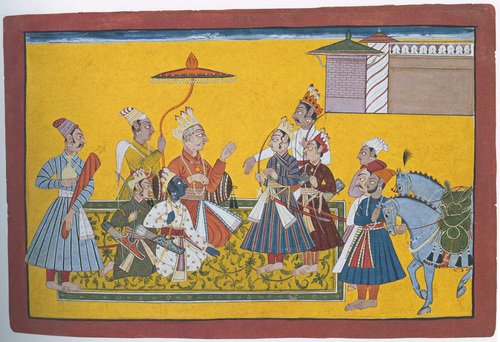| Dasharatha’s Four Sons/Image Source: MET Museum |
Shatrughna is frequently seen as the understated champion of the Ramayana. While his brothers—with Rama, Lakshmana, and Bharata taking center stage—Shatrughna’s importance resonates quietly. Revered as the embodiment of Vishnu’s Sudarshana Chakra, the sacred discus, he signifies the eradication of malevolence and the safeguarding of dharma. This reflects Shatrughna’s profound yet subtle influence in the epic.
Even though Shatrughna’s presence may not be overt, his crucial act of defeating the demon Lavanasura showcases his dedication to righteousness. His deeds ensured the safety of the realm and upheld the legacy of the Ikshvaku dynasty, akin to the role of the Sudarshana Chakra in maintaining universal harmony.
Here are three notable names connected to Shatrughna that illustrate his essence and contributions:
1. Ripudaman
The term Ripudaman translates to “the conqueror of foes.” This designation perfectly encapsulates Shatrughna’s prowess in vanquishing evil, even if his feats often escape the spotlight. Among his notable achievements is the defeat of Lavanasura, a formidable demon who wreaked havoc upon the land of Madhupura (Mathura). His triumph over Lavanasura was swift and impactful, mirroring the efficiency of the Sudarshana Chakra he embodies.
This name emphasizes Shatrughna’s capability to eliminate potent adversaries in the pursuit of dharma, irrespective of how overshadowed his victories may be by the more prominent actions of his siblings.
2. Shatrughati
Shatrughati means “the slayer of enemies,” aptly defining Shatrughna’s essence as a warrior dedicated to eradicating evil. Though he is not one who seeks accolades, Shatrughna’s deeds resonate profoundly. This moniker mirrors his quiet resolve to champion the greater good, acting promptly and with justice during crises. He stood guard over Ayodhya in the absence of Rama, Bharata, and Lakshmana.
3. Sumitranandan
Another significant name is Sumitranandan, which translates to “son of Sumitra and Dasharatha.” Shatrughna, with his twin brother Lakshmana, was born to Queen Sumitra, the second consort of King Dasharatha. This title highlights his noble pedigree, and his bond with his mother is often remembered for imparting principles of loyalty and servitude. Queen Sumitra was instrumental in nurturing both her sons’ unwavering support for their elder brothers—Rama and Bharata. The name Sumitra Nandan serves as a reminder of his familial responsibilities and the virtuous values instilled by his parents.
4. Lakshmana Anuja
The name Lakshmana Anuja signifies “younger brother of Lakshmana.” This title underscores the strong bond Shatrughna shares with his brothers, particularly with Lakshmana, similar to how Bharata is often referred to as Ramanuja, the younger sibling of Rama. Shatrughna’s steadfast allegiance to his brothers, notably in backing Bharata’s reign during Rama’s exile, highlights his role as a devoted guardian of his family and dharma.
While not always in the limelight, Shatrughna’s unwavering fidelity and support for his brothers were instrumental in sustaining the equilibrium within the Ikshvaku dynasty. His connections with Lakshmana, Bharata, and Rama lay the foundation for his quiet yet significant contributions to their shared mission of upholding righteousness.
Through these names, Shatrughna’s character is unveiled—whether through his valiance in combat, unyielding loyalty, or humble dedication to preserving dharma. Much like the Sudarshana Chakra plays an essential role in Vishnu’s armory, Shatrughna’s actions, although often underappreciated, are critical to the maintenance of peace and order in the realm of the Ramayana.

